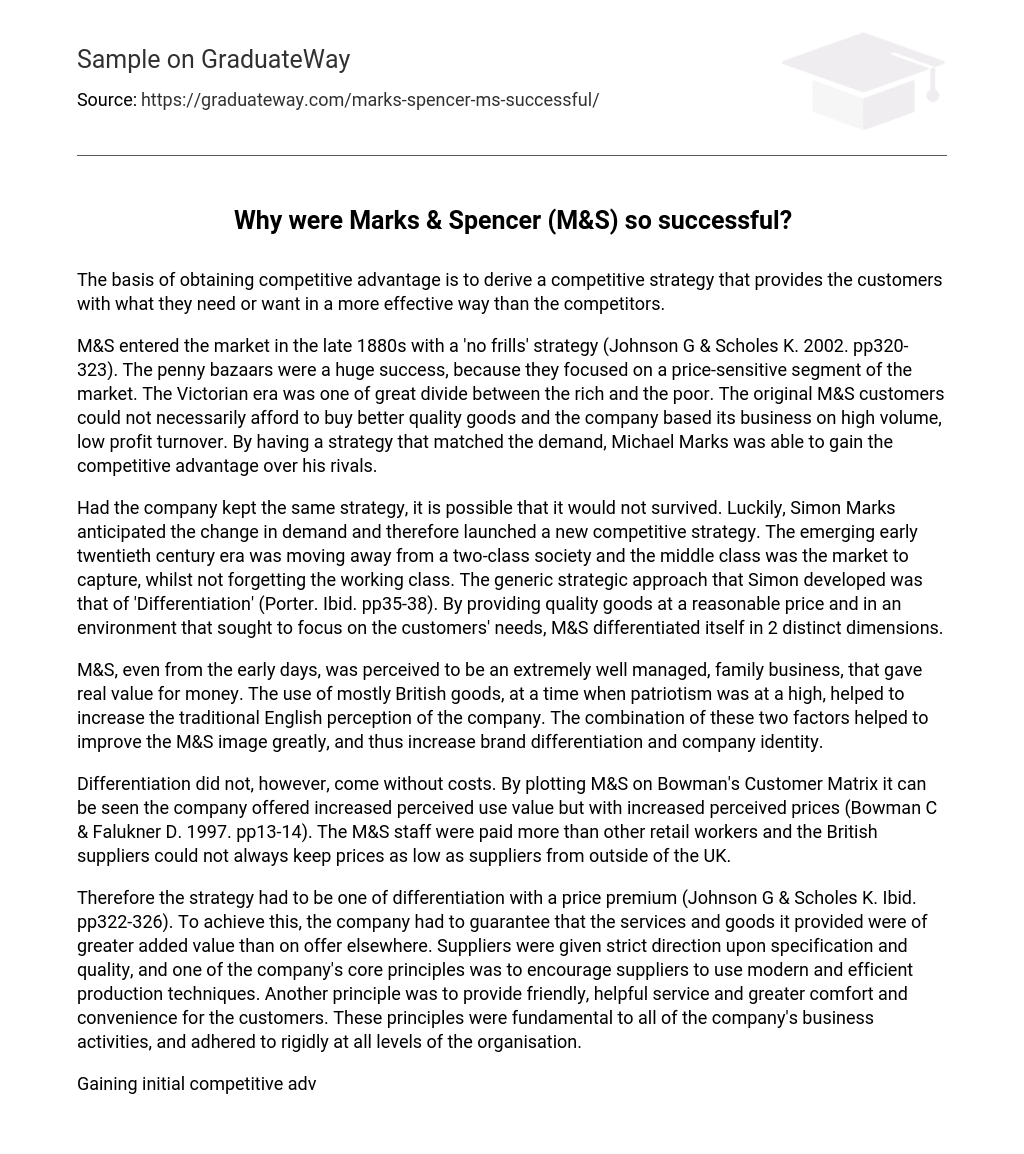The basis of obtaining competitive advantage is to derive a competitive strategy that provides the customers with what they need or want in a more effective way than the competitors.
M&S entered the market in the late 1880s with a ‘no frills’ strategy (Johnson G & Scholes K. 2002. pp320-323). The penny bazaars were a huge success, because they focused on a price-sensitive segment of the market. The Victorian era was one of great divide between the rich and the poor. The original M&S customers could not necessarily afford to buy better quality goods and the company based its business on high volume, low profit turnover. By having a strategy that matched the demand, Michael Marks was able to gain the competitive advantage over his rivals.
Had the company kept the same strategy, it is possible that it would not survived. Luckily, Simon Marks anticipated the change in demand and therefore launched a new competitive strategy. The emerging early twentieth century era was moving away from a two-class society and the middle class was the market to capture, whilst not forgetting the working class. The generic strategic approach that Simon developed was that of ‘Differentiation’ (Porter. Ibid. pp35-38). By providing quality goods at a reasonable price and in an environment that sought to focus on the customers’ needs, M&S differentiated itself in 2 distinct dimensions.
M&S, even from the early days, was perceived to be an extremely well managed, family business, that gave real value for money. The use of mostly British goods, at a time when patriotism was at a high, helped to increase the traditional English perception of the company. The combination of these two factors helped to improve the M&S image greatly, and thus increase brand differentiation and company identity.
Differentiation did not, however, come without costs. By plotting M&S on Bowman’s Customer Matrix it can be seen the company offered increased perceived use value but with increased perceived prices (Bowman C & Falukner D. 1997. pp13-14). The M&S staff were paid more than other retail workers and the British suppliers could not always keep prices as low as suppliers from outside of the UK.
Therefore the strategy had to be one of differentiation with a price premium (Johnson G & Scholes K. Ibid. pp322-326). To achieve this, the company had to guarantee that the services and goods it provided were of greater added value than on offer elsewhere. Suppliers were given strict direction upon specification and quality, and one of the company’s core principles was to encourage suppliers to use modern and efficient production techniques. Another principle was to provide friendly, helpful service and greater comfort and convenience for the customers. These principles were fundamental to all of the company’s business activities, and adhered to rigidly at all levels of the organisation.
Gaining initial competitive advantage through differentiation was relatively easy. Sustaining advantage was key to the survival of the organisation. M&S had developed culturally embedded core competencies that ranged across the value chain. The close links and co-operative work with the suppliers meant that it was hard for competitors to provide identical quality goods. The distribution and supply networks had been developed over a long time and were well established. The brand name, an intangible asset, was highly regarded and extremely well known. Due to the M&S ethos, and the increased rates of pay, the company attracted a higher calibre of sales staff. The ‘no quibble’ M&S guarantee was deep rooted into the psyche of the organisation. All of these competencies were extremely difficult to imitate and were key to the company sustaining its advantage (Hamel G & Prahalad C. 1996. p229).
M&S considered growth as another essential element in sustaining competitive advantage. The risk aversive company did not diversify greatly and concentrated on its core values, competencies and principles. It had been extremely successful providing generic essential products without the need to try to match what other retailers were offering. Growth was therefore confined to the quantity of the market share and the number of retail outlets. By continuing to increase the number of shops, M&S was able to build barriers against competition through geographical strongholds. The purchase of 19 Littlewoods department stores in prime locations proves that this was one of the strategies employed by the company.
M&S held Strategic Excellence Positions (SEPs), the ability to do things better than its competitors, in all 3 key areas (P�mpin. 1987. pp19-26). A product related SEP through the recognition of the customer requirement. A market related SEP via its renowned image and brand, and functional SEPs by offering value for money goods and a quality service. This was the basis for the M&S competitive advantage. By staying close to its core competencies it was then able to sustain the advantage.
BIBLIOGRAPHY
Bowman C. (1990). The Essence of Strategic Management. Prentice Hall.
Bowman C, Faulkner D. (1997). Competitive and Corporate Strategy. Irwin.
Hamel G, Prahalad C. (1996). Competing for the Future. Harvard Business School Press.
Johnson G, Scholes K. (2002). Exploring Corporate Strategy. (6th ed). Prentice Hall.
Porter M. (1980). Competitive Strategy. The Free Press.
P�mpin C. (1987). The Essence of Corporate Strategy. Gower Publishing.
Rosen R. (1995). Strategic Management, an Introduction. Pitman Publishing.
What was Marks & Spencer’s basis of competitive advantage? By M S SMYTH





